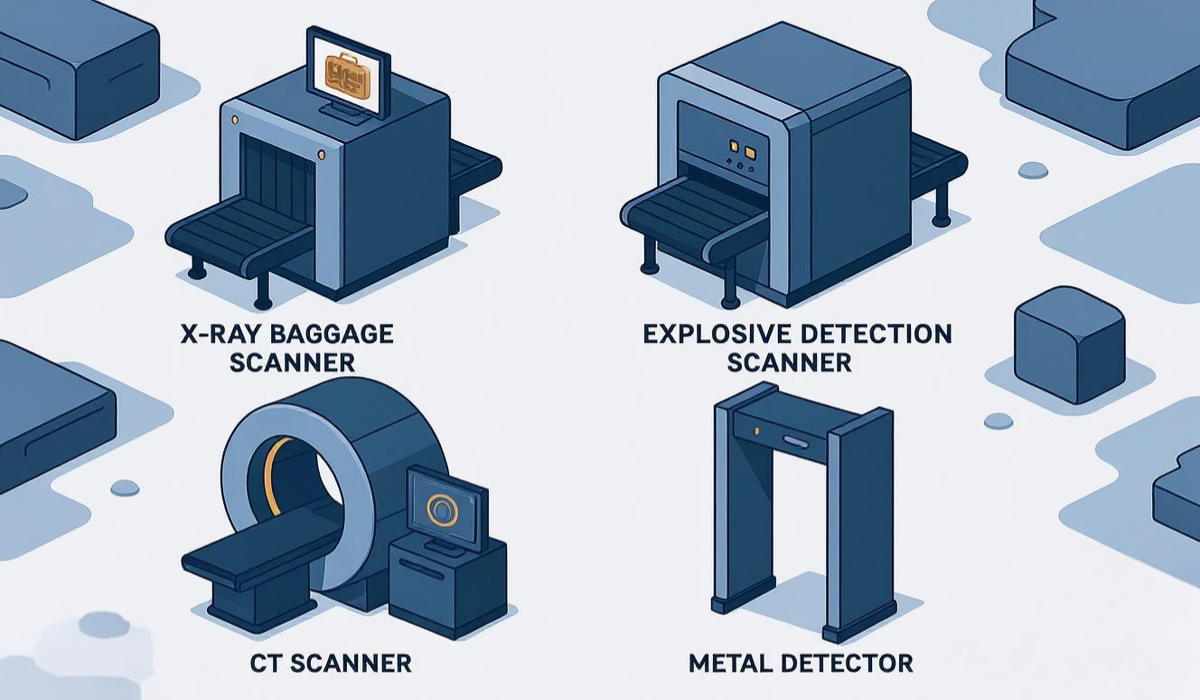In India, modern travel has become both thrilling and surprisingly seamless, thanks to remarkable technology like baggage scanners. But how much do you really know about them? Discovering the different types of baggage scanners, especially the cutting-edge and ever-reliable X-ray baggage scanners, can empower you to appreciate the science behind your safety while satisfying both curiosity and a sense of wonder.
What Are Baggage Scanners?
Baggage scanners are powerful security devices used to examine luggage at airports, railway stations, hotels, malls, and official buildings. They detect potential threats without opening your bags, using advanced imaging technology. The most impactful of these are X-ray baggage scanners, which use X-ray vision to reveal what’s hidden inside, giving screeners a clear and fast inspection process.
Types of Baggage Scanners-
To ensure travel remains secure and hassle-free, it’s vital to explore the different types of baggage scanners available in today’s security landscape. Each type serves a unique purpose and offers a different level of efficiency and safety. Understanding the types can help you realize how vital these devices are for keeping journeys safe and smooth.
Main Types of Baggage Scanners-
1. X-ray Baggage Scanner
The most exciting and essential scanner for most airports and checkpoints is the X-ray baggage scanner. Let’s reveal why:
- Non-invasive: Most items remain intact, so belongings aren’t disturbed.
- Speed: Large volumes of bags are scanned in moments, making queues shorter.
- Clarity: Security staff receive detailed images of bag contents, improving threat detection.
- Versatility: They detect metals, liquids, explosives, and more.
The genius of the X-ray baggage scanner lies in its ability to show what human eyes can’t see—unpacking mysteries, enhancing safety, and speeding up travel, all at once.
2. Explosive Detection Baggage Scanners
Some threats require more than just X-ray vision. Explosive detection scanners use highly sensitive sensors and swift analysis to pinpoint hazardous materials. They may incorporate chemical sniffers or advanced X-ray algorithms to flag risky substances, offering another layer of crucial protection.
3. Computed Tomography (CT) Baggage Scanners
CT baggage scanners are an advanced marvel, utilizing three-dimensional imaging—think of them as the superheroes of airport security! CT scanners rotate around bags, generating detailed cross-sectional images. Not only can they detect dense items, but they can also distinguish between organic materials and threat substances with impressive accuracy.
4. Metal Detector Baggage Scanners
Though often associated with walk-through gates, metal detector scanners exist for baggage, too. They excel at identifying knives, firearms, and other metallic danger items hidden in luggage. While less versatile than an X-ray baggage scanner, they still play a valuable supporting role.
5. Manual/Visual Inspection
Sometimes, old-fashioned methods are still employed, especially for suspicious objects or locations without tech infrastructure. However, these are subject to human error and are far less efficient than automated options like the X-ray baggage scanner.
Benefits of Using Different Types of Baggage Scanners
Choosing the correct types of baggage scanners creates an incredible boost in both safety and convenience. Here’s how:
- Enhanced Security: Multiple scanning types mean wider coverage against a range of threats.
- Faster Processing: Automated technology keeps lines speedy and travelers happy.
- Reduced Human Error: Machines rarely overlook what the human eye could miss.
| Types of Baggage Scanners | Detection Method | Application Area | Key Features |
| X-ray baggage scanner | X-ray imaging | Airports, stations | Fast, detailed internal image |
| Explosive detection scanner | Chemical/algorithm | High-security points | Detects explosives, powders, and liquids |
| CT baggage scanner | 3D X-ray (CT) | Large airports | 3D images, detailed analysis |
| Metal detector baggage scanner | Electromagnetic fields | Checkpoints, venues | Finds metallic objects |
| Manual/visual inspection | Human inspection | Low-tech areas | Direct examination, less reliable |
How to Choose the Best Types of Baggage Scanners
Selecting the right baggage scanner is essential—after all, the safety and satisfaction of travelers depend on it!
- Space: Compact scanners are available for smaller venues and offices.
- Volume of Passengers: Busy airports need X-ray and CT baggage scanners.
- Threat Level: Facilities exposed to higher threats benefit from multi-layered scanners, including explosive detection models.
- Budget: X-ray baggage scanners strike the perfect balance between cost and reliability.
Frequently Asked Questions on Types of Baggage Scanners
1. Are X-ray baggage scanners safe for my electronics and medicines?
A: Yes—current X-ray baggage scanners are designed to avoid damaging your devices or personal items.
2. How do I know which types of baggage scanners an airport uses?
A: Most major airports use X-ray baggage scanners as their main line of defense, often supported by metal detectors and sometimes CT or explosive detection models.
3. Do scanners invade my privacy?
A: No images are stored, and only authorized personnel view the scans, especially with X-ray baggage scanners.
Conclusion: Why the Right Types of Baggage Scanners Matter
Choosing the most powerful types of baggage scanners, especially a reliable X-ray baggage scanner, is crucial for efficient, safe, and smooth travel experiences. Next time you glide through security with ease and confidence, you’ll know the incredible technology working behind the scenes, tirelessly keeping your world safe.


[…] Comparing Popular Baggage Scanner Types […]